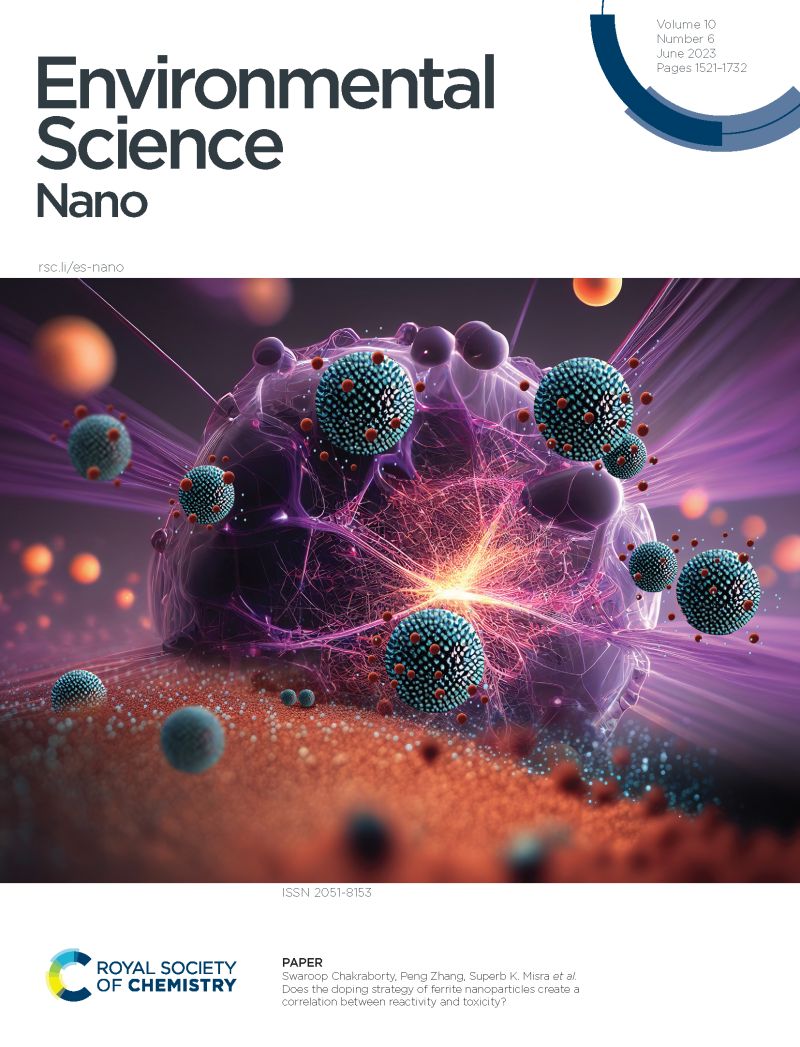Toxic effects and metabolic response mechanisms of amino-modified polystyrene nanoplastics and arsenic on Microcystis aeruginosa
IF 5.8
2区 环境科学与生态学
Q1 CHEMISTRY, MULTIDISCIPLINARY
引用次数: 0
Abstract
Plastic contamination poses an increasing threat to our environment, particularly with the accumulation of nanoplastics (NPs, <1 µm) in aquatic systems. Amino-modified polystyrene nanoplastics (PSNPs-NH₂), due to their high reactivity and biocompatibility, may exert toxic effects on aquatic organisms like cyanobacteria. Microcystis aeruginosa (M. aeruginosa), a common cyanobacterium widely distributed in aquatic ecosystems, plays a crucial role as a primary producer and is sensitive to NPs and arsenic (As) contamination. This work examined the effects of PSNPs-NH₂ alone (PS), As alone (As), and co-exposure (AP) on Microcystis aeruginosa using exposure experiments, three-dimensional excitation-emission matrix (3D-EEM) fluorescence spectroscopy, and metabolomics. Results indicated that amino-modified polystyrene nanoplastics significantly inhibited M. aeruginosa growth, with chlorophyll a content reduced by 12.28%-12.96% at high doses amino-modified polystyrene nanoplastics increased intracellular O₂·⁻ levels by 5.10% - 15.75%, while Arsenic significantly elevated H₂O₂ levels by 2454.92%, which decreased by 74.61% - 87.76% under AP. Arsenic and AP increased intracellular and extracellular microcystin. Metabolomic analysis indicated that amino-modified polystyrene nanoplastics upregulated amino sugar metabolism to enhance extracellular polymeric substances (EPS) secretion, while AP activated fatty acid degradation to cope with stress. In summary, the research reveals the multi-level toxic impacts of PSNPs-NH₂ and arsenic, alone and co-exposure on Microcystis aeruginosa, providing scientific underpinnings for evaluating the potential threats of nanoplastics and metal (loid) co-exposure to aquatic ecosystems.氨基修饰聚苯乙烯纳米塑料和砷对铜绿微囊藻的毒性作用及代谢反应机制
塑料污染对我们的环境构成越来越大的威胁,特别是随着纳米塑料(NPs, <;1微米)在水生系统中的积累。氨基改性聚苯乙烯纳米塑料(PSNPs-NH 2)由于其高反应性和生物相容性,可能对蓝藻等水生生物产生毒性作用。铜绿微囊藻(Microcystis aeruginosa, M. aeruginosa)是一种广泛分布于水生生态系统中的常见蓝藻,对NPs和砷(as)污染非常敏感,具有重要的初级生产者作用。本研究通过暴露实验、三维激发-发射矩阵(3D-EEM)荧光光谱和代谢组学研究了psnp - nh₂单独(PS)、As单独(As)和共暴露(AP)对铜绿微囊藻的影响。结果表明,氨基改性聚苯乙烯nanoplastics显著抑制m .绿脓杆菌生长和叶绿素含量降低了12.28% -12.96%,高剂量氨基改性聚苯乙烯nanoplastics胞内O₂·⁻水平增加了5.10% - 15.75%,而砷显著H₂O₂水平升高了2454.92%,这在美联社下降了74.61% - 87.76%。砷和美联社增加细胞内和细胞外对国内外。代谢组学分析表明,氨基修饰聚苯乙烯纳米塑料上调氨基糖代谢,增强细胞外聚合物(EPS)的分泌,而AP则激活脂肪酸降解以应对应激。综上所述,本研究揭示了psnp - nh2和砷单独和共暴露对铜绿微囊藻的多级毒性影响,为评价纳米塑料和金属(loid)共暴露对水生生态系统的潜在威胁提供了科学依据。
本文章由计算机程序翻译,如有差异,请以英文原文为准。
求助全文
约1分钟内获得全文
求助全文
来源期刊

Environmental Science: Nano
CHEMISTRY, MULTIDISCIPLINARY-ENVIRONMENTAL SCIENCES
CiteScore
12.20
自引率
5.50%
发文量
290
审稿时长
2.1 months
期刊介绍:
Environmental Science: Nano serves as a comprehensive and high-impact peer-reviewed source of information on the design and demonstration of engineered nanomaterials for environment-based applications. It also covers the interactions between engineered, natural, and incidental nanomaterials with biological and environmental systems. This scope includes, but is not limited to, the following topic areas:
Novel nanomaterial-based applications for water, air, soil, food, and energy sustainability
Nanomaterial interactions with biological systems and nanotoxicology
Environmental fate, reactivity, and transformations of nanoscale materials
Nanoscale processes in the environment
Sustainable nanotechnology including rational nanomaterial design, life cycle assessment, risk/benefit analysis
 求助内容:
求助内容: 应助结果提醒方式:
应助结果提醒方式:


